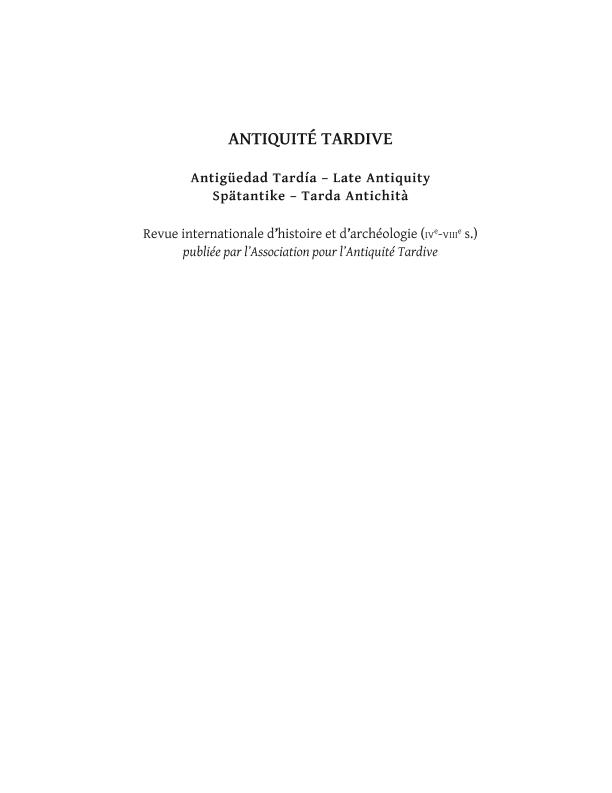Mostrar el registro sencillo del ítem
dc.contributor.author
Laham Cohen, Rodrigo Jaime

dc.date.available
2018-05-10T20:30:44Z
dc.date.issued
2016-10
dc.identifier.citation
Laham Cohen, Rodrigo Jaime; La confusión como estrategia retórica: María y Jesús en b Shabat 104b y b Sanedrín 67a; Brepols; Antiquité Tardive; 24; 10-2016; 285-305
dc.identifier.issn
1250-7334
dc.identifier.uri
http://hdl.handle.net/11336/44827
dc.description.abstract
Discussions around Jesus´ family have led to animated debates both in Antiquity and in contemporary historiography. Due to the paucity of sources, historians have resorted to the wide range of materials available on that subject, including the tale about Maria in the Babylonian Talmud found in Shabbat 104b and in Sanhedrin 67a. Throughout the 20th century, scholars have sought to understand the role of prominent figures, such as Ben Stadá, Pantira or Pappos ben Yehuda, in those texts; some of them have even tried to find trails of the historical Jesus. Recently, however, other historians have focused the analysis not on the historical Maria, but on Maria´s image in the Bavlí, its motivations and its aims. Nevertheless, most scholars have held that the confusion that appears in the Talmudic text when explaining Jesus´ family was the result of rabbinical ignorance.In this paper, we seek to demonstrate that the confusion apparent in b Shabbat 104b and in b Sanhedrin 67a is not a consequence of ignorance. It is, in fact, a discursive device oriented to: 1) Desacralize Maria´s figure and, accordingly, that of Jesus; 2) Invert the accusations of carnality and impudicity that had constructed the Adversus Iudaeos? literature. Such position implies rabbinical knowledge of the Christian narrative, not only through the New Testament but also through direct interaction. This view is supported by the existence of an important degree of contact between Jews and Christians in the formative centuries of both talmudim, in agreement with current studies on the relations between both religious communities in the east of the Roman Empire and in the Sasanian Empire during Late Antiquity.
dc.format
application/pdf
dc.language.iso
spa
dc.publisher
Brepols
dc.rights
info:eu-repo/semantics/openAccess
dc.rights.uri
https://creativecommons.org/licenses/by-nc-sa/2.5/ar/
dc.subject
Talmud
dc.subject
Literatura Anticristiana
dc.subject
Judaísmo
dc.subject
Jesús
dc.subject.classification
Historia

dc.subject.classification
Historia y Arqueología

dc.subject.classification
HUMANIDADES

dc.title
La confusión como estrategia retórica: María y Jesús en b Shabat 104b y b Sanedrín 67a
dc.title
Confusion as a rhetotical strategy: Mary and Jesus in b Shabbat 104b and b Sanhedrin 67a
dc.type
info:eu-repo/semantics/article
dc.type
info:ar-repo/semantics/artículo
dc.type
info:eu-repo/semantics/publishedVersion
dc.date.updated
2018-04-27T13:28:48Z
dc.identifier.eissn
2295-9718
dc.journal.volume
24
dc.journal.pagination
285-305
dc.journal.pais
Bélgica

dc.journal.ciudad
Turnhout
dc.description.fil
Fil: Laham Cohen, Rodrigo Jaime. Consejo Nacional de Investigaciones Científicas y Técnicas. Oficina de Coordinación Administrativa Saavedra 15. Instituto Multidisciplinario de Historia y Ciencias Humanas; Argentina. Universidad de Buenos Aires; Argentina. Universidad Nacional de San Martín; Argentina
dc.journal.title
Antiquité Tardive
dc.relation.alternativeid
info:eu-repo/semantics/altIdentifier/doi/http://dx.doi.org/10.1484/J.AT.5.112630
dc.relation.alternativeid
info:eu-repo/semantics/altIdentifier/url/https://www.brepolsonline.net/doi/abs/10.1484/J.AT.5.112630
Archivos asociados
